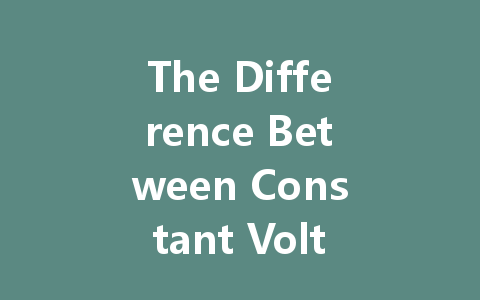Johdanto
LED drivers play a crucial role in powering LED lights, ensuring they operate effectively and efficiently. Understanding the difference between constant voltage and constant current drivers is essential for anyone involved in LED lighting design, installation, or maintenance. In this article, we’ll explore the principles behind these two types of drivers, their characteristics, advantages, and applications.
Mitä ovat LED-ohjaimet?
LED-ajurit are power supplies designed specifically for LED lighting. They regulate the power supplied to the LEDs, allowing for consistent brightness and extending the lifespan of the lights. The type of driver used—constant voltage or constant current—impacts how the LEDs will perform under various conditions.
Vakiojännite-LED-ohjaimet
Definition and Characteristics
Vakiojännite LED driver maintains a steady output voltage regardless of changes in load current. Typically rated at specific voltages like 12V, 24V, or 48V, these drivers are ideal for systems where the total load (number of LEDs) can vary without significantly affecting the overall performance.
Vakiojänniteajureiden edut
Vakiojänniteajureiden sovellukset
Constant voltage drivers are commonly used in LED strip lighting, decorative lighting, and signage applications where uniformity and simplicity are key. They are particularly effective in environments where load variation is expected.
Vakiovirtaiset LED-ohjaimet
Definition and Characteristics
Unlike constant voltage drivers, constant current LED drivers supply a consistent current to the LED load, which is crucial for maintaining brightness and color consistency. As the load changes, these drivers automatically adjust the voltage to keep the current steady, typically providing output options such as 350mA, 700mA, or 1A.
Vakiovirta-ajureiden edut
Vakiovirta-ajureiden sovellukset
These drivers are predominantly utilized in applications requiring high-efficiency lighting, such as street lights, architectural lighting, and specialized medical or industrial lighting setups. Their ability to manage current makes them essential for high-performance LED applications.
Keskeiset erot vakiojännite- ja vakiovirta-ajureiden välillä
Performance Stability
The primary distinction lies in their operation: constant voltage drivers focus on maintaining voltage, while constant current drivers prioritize current stability. Therefore, the choice between them significantly influences the LED system’s performance.
Installation Flexibility
Constant voltage systems allow for a more straightforward setup with extensive wiring options, making them easier to implement in DIY projects or large-scale installations. Conversely, constant current setups may require more precise load calculations to ensure the driver meets the current needs of the LEDs.
Cost Considerations
In general, constant current drivers are often more specialized and can be pricier than their constant voltage counterparts. However, the investment may be justified by the enhanced performance and longevity they bring to certain high-demand applications.
When to Use Each Type of Driver
Choosing Constant Voltage
Opt for constant voltage drivers in applications where a large number of LEDs share a power source and flexibility is essential. They work well in decorative lighting setups and installations where the overall load might change.
Choosing Constant Current
Select constant current drivers when working with high-performance lighting applications that demand precise color and brightness control. They are preferable in environments where reliability and durability are paramount.
Päätelmä
Understanding the difference between constant voltage and constant current LED drivers is vital for anyone involved in lighting design and installation. By choosing the correct driver, you can ensure your LED system performs optimally, achieves the desired aesthetic, and lasts longer. Whether you need a straightforward constant voltage solution or the precise regulation of a constant current driver, knowing the essentials will lead you to make informed decisions that enhance your lighting projects.
